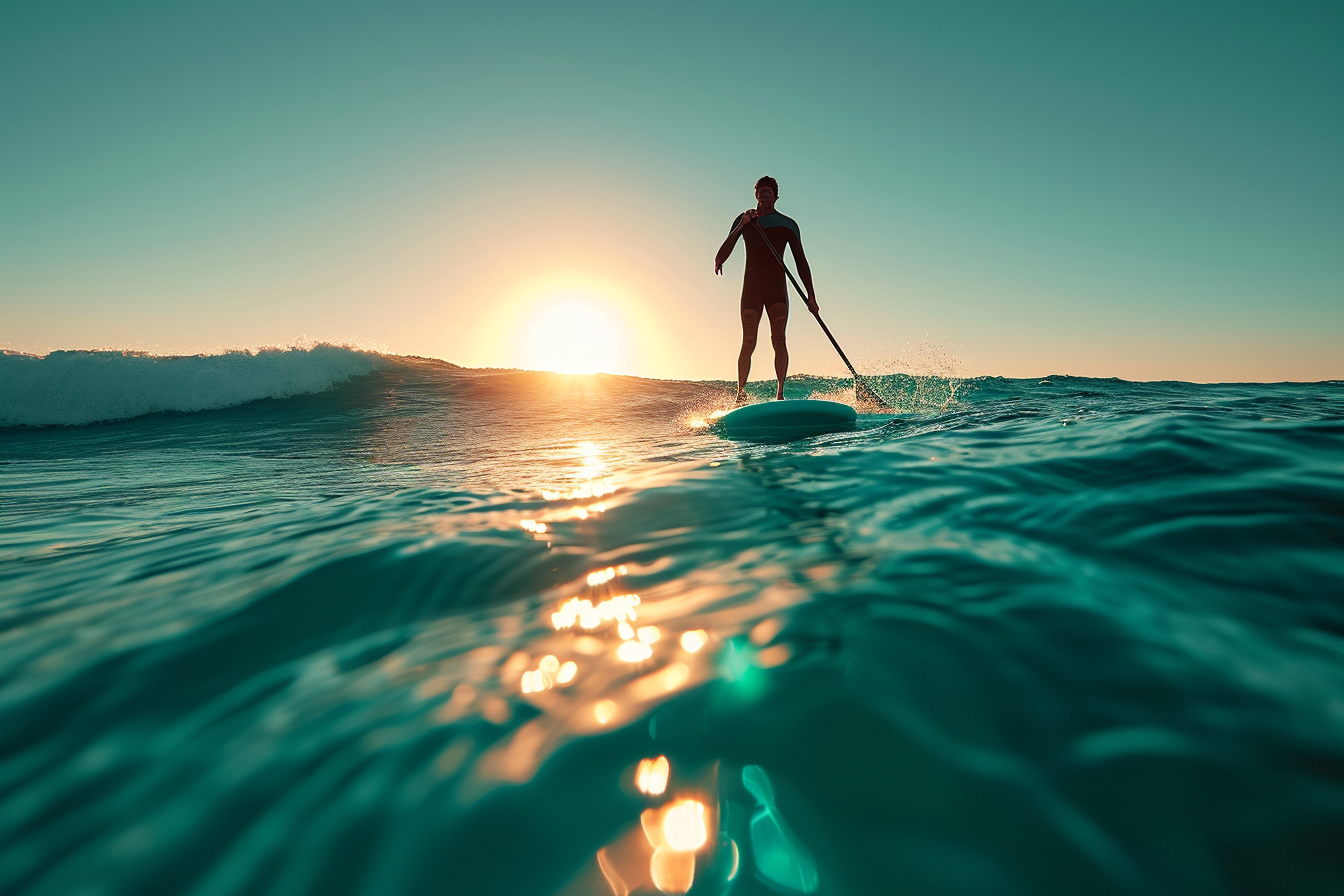
Yolo Boarding, or stand-up paddleboarding (SUP), is a water sport that has been gaining tremendous popularity over the past decade. Originating from the beautiful coasts of Hawaii, it combines the thrill of surfing with the tranquility of paddling across serene waters. Yolo Boarding offers a unique way to explore varied aquatic environments while providing an excellent full-body workout. Whether slicing through ocean waves or cruising along a calm lake, this activity appeals to adventure-seekers and peace-lovers alike.
Embarking on your Yolo Boarding journey requires a mix of physical preparedness, understanding of the equipment, and respect for the environment. Success in this endeavor comes from grasping the fundamentals and progressively mastering advanced techniques.
Selecting your equipment
The yolo board
The heart of your Yolo Boarding setup is the board itself. Paddleboards come in various shapes and sizes, and choosing the right one depends on your weight, experience, and the type of water you’ll be exploring. Generally, wider and longer boards offer greater stability, which is particularly helpful for beginners. In contrast, seasoned paddlers may opt for narrower boards that provide enhanced speed and maneuverability.
Construction materials
Yolo Boards can be constructed from various materials offering different balance points between durability, weight, and cost:
- Epoxy and Fiberglass: These boards are stiff and lightweight, offering good performance but at a higher price point.
- Inflatable: Featuring an air core covered by robust fabric, inflatable boards are user-friendly, portable, and ideal for casual use.
- Plastic: This variety typically represents the budget-friendly end of the spectrum, providing robustness but sacrificing performance and weight advantages.
The paddle
Selecting the proper paddle is just as crucial as finding the right board. The ideal paddle length is approximately 6 to 8 inches taller than the paddler. A paddle that’s too short will force you to bend more, causing back strain, while one that’s too long can lead to inefficient paddling techniques.
Paddle materials
Paddles come in different materials, each with its benefits:
- Aluminum: Affordable but a bit heavier, these paddles suit those just starting out.
- Carbon Fiber: For the avid paddler, carbon fiber offers the best strength-to-weight ratio, albeit at a higher cost.
- Wood: Traditional and aesthetically pleasing, wood paddles blend performance with a natural feel.
Starting your yolo boarding adventure

Foundations of paddleboarding
Embarking on any new sport requires learning the basics, and in the case of Yolo Boarding, these consist of balancing, paddling, and maneuvering.
Balancing on the board
Finding your balance is the first skill to master. Start by practicing on calm water:
- Position Feet Properly: Stand with your feet parallel, about hip-width apart, centered between the edges of the board.
- Stay Low: Begin by kneeling on the board to get a feel for the water’s motion.
- Rise Carefully: Once comfortable, stand up one foot at a time, keeping your knees slightly bent.
Correct paddling technique
Effective paddling is a matter of technique rather than brute force:
- Grip: Place one hand on the top of the paddle and the other on the shaft, shoulder-width apart.
- Strokes: Use your core rather than your arms to paddle. Push the paddle blade fully into the water and pull it back towards your ankle before lifting it out.
Safety considerations
Prioritizing safety ensures that your Yolo Boarding experience is enjoyable and free from harm. Always check the weather and water conditions before hitting the water. Beginners should also invest in a Personal Flotation Device (PFD) and consider using a leash that tethers you to the board.
Enhancing your skills
Advanced balancing techniques
As you gain confidence in your ability to stand and paddle, practice shifting your weight to navigate small waves and wake:
- Moving Feet: Learn to walk up and down the board to adjust its trim according to water conditions.
- Engaging Core: Strengthening your core muscles contributes significantly to improving balance.
Navigation and maneuverability
Maneuvering your Yolo Board requires mastery over various paddling techniques, such as:
- Forward Stroke: The essential stroke for propelling the board.
- Reverse Stroke: Useful for stopping or moving backward.
- Sweep Stroke: A wide arcing paddle movement on one side of the board to turn it.
- Cross Bow Stroke: A technique where the paddle moves in front of the paddler to turn the board in the opposite direction.
Yolo boarding etiquette and conservation
Respecting others
Yolo Boarding, like all water sports, has its set of unwritten rules. It’s vital to remain mindful of other water users:
- Keep Your Distance: Maintain a reasonable space between yourself and swimmers, surfers, and fellow paddlers.
- Yielding: When crossing paths with another paddler or surfer, the person closest to the peak of the wave (the highest point) generally has the right of way.
- Overtaking: Similar to road rules, if overtaking someone, do so on their left side and communicate your intention.
Environmental stewardship
The privilege of enjoying natural waterways comes with the responsibility of conservation. Yolo Boarding allows for up-close experiences with aquatic ecosystems, but it is essential to:
- Avoid Disruption: Steer clear of sensitive areas like coral reefs or nesting grounds.
- Leave No Trace: Ensure that nothing you bring to the water, like food wrappers or water bottles, gets left behind.
- Promote Clean Waters: If you encounter trash on your journey, consider picking it up to keep the environment pristine for other users.
Training and fitness
Yolo boarding as exercise
The full-body workout provided by Yolo Boarding can improve your health in several ways:
- Core Strength: The constant balance adjustments engage your core muscles.
- Upper Body Conditioning: Paddling works your shoulders, arms, and back.
- Lower Body Workout: Your legs continually work to stabilize your position on the board.
- Cardiovascular Health: Regular paddling increases heart rate, contributing to overall cardiovascular fitness.
Cross-Training opportunities
To enhance your Yolo Boarding abilities, consider incorporating additional forms of exercise:
- Yoga: Improves balance, flexibility, and core strength, all vital for proficient boarding.
- Swimming: Boosts endurance and gives confidence in water.
- Strength Training: Builds up the muscle strength required for powerful paddling.
Exploring new horizons
Venturing into different waters
Once you feel comfortable on your local waterways, seek out new environments to board:
- Ocean Paddleboarding: Challenges you with waves and currents.
- River Paddling: Adds a touch of whitewater adventure.
- Long-Distance Touring: Allows you to cover greater distances and potentially camp along the way.
Joining the community
Becoming involved in the Yolo Boarding community enriches the experience:
- Group Paddles: Many areas have clubs or meet-ups, which are excellent for learning tips from experienced boarders and finding companionship.
- Races and Competitions: For the competitive paddler, races are a thrilling way to test skills against others.
- SUP Yoga and Fitness Classes: Specialty classes combine paddleboarding with wellness practices, further diversifying the sport’s appeal.
Progressing in the sport
Setting goals
Advancing in Yolo Boarding entails setting personal goals, such as mastering specific maneuvers, increasing paddling distances, or even teaching others. Progress often comes from pushing personal boundaries while always maintaining respect for the water’s power.
Continuing education
Continuous learning is part of any sport. Consider taking advanced lessons, attending workshops, or learning from online resources. Seasoned boarders often have a wealth of knowledge to share, providing insights into more nuanced aspects of the sport.
Wrapping up
Mastering the waves through Yolo Boarding is a journey that combines the excitement of a water sport with the tranquility of being close to nature. From selecting the right gear to honing your paddling techniques, the discipline unfolds as an adventure that continually evolves. By respecting the environment and others, fostering a sense of community, and persistently pushing your limitations, you’ll discover the profound joys and lifelong rewards that come from Yolo Boarding. As you advance in proficiency and experience, the horizon of possibilities expands—inviting you to explore new waters and further refine your skills.
The path to Yolo Boarding mastery is one of patience, practice, and passion. With every stroke and every wave, growth and fulfillment await. Embrace the challenge, cherish the learning curve, and revel in the splendor of each paddle-powered voyage.
As the sun sets on this introduction to Yolo Boarding, remember that with each dawn, the waters beckon anew—offering another chance to progress, explore, and perhaps most importantly, to truly live out loud.